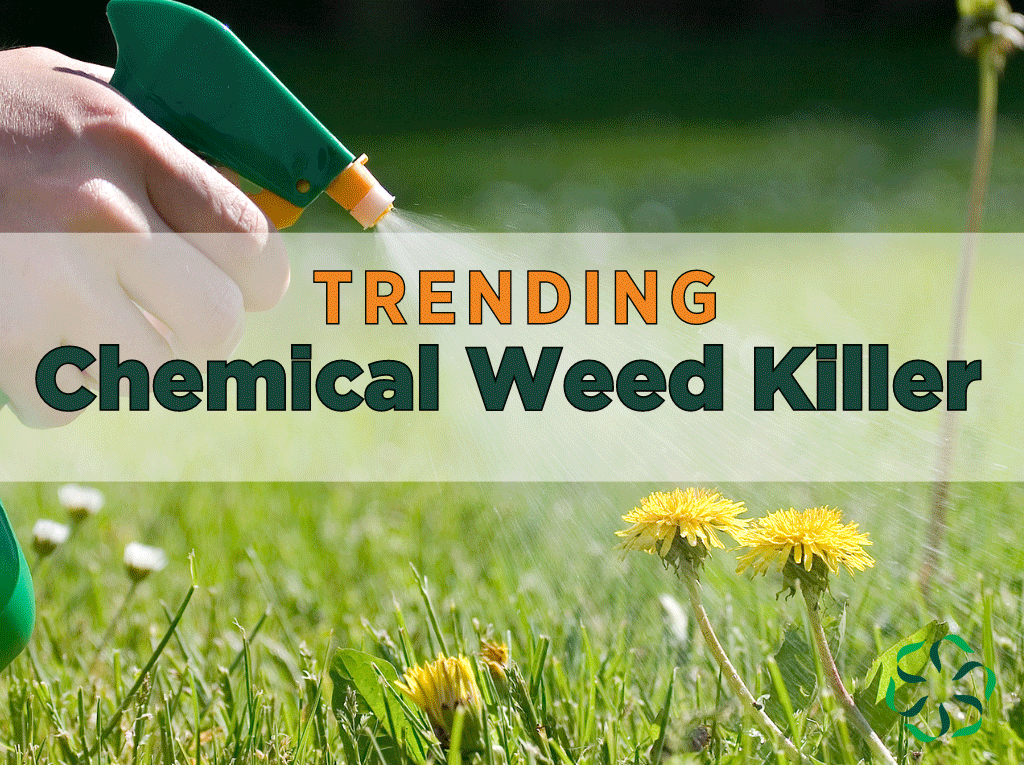Chemical weed killers often raise concerns among gardeners and homeowners. In this post, we provide a general overview of chemical weed killers.
What is a chemical weed killer?
A chemical weed killer known as a herbicide controls or eliminates unwanted plants. Herbicides play a crucial role in agriculture, landscaping, and gardening by helping to manage plant competition with desired plant or crop growth.
Are herbicides and pesticides the same or different?
Herbicides are a type of pesticide.
Pesticides encompass a wider range of chemicals designed to manage various types of unwanted organisms, including:
- Insecticides (insects)
- Rodenticides (rodents)
- Fungicides (fungi)
- Herbicides (plants)
- Bactericides (bacteria)
- Nematicides (parasitic worms)
What are active ingredients found in common chemical weed killers?
Common active ingredients in conventional chemical weed killers may include:
- 2,4-Dichlorophenoxyacetic Acid (2,4-D): a selective herbicide that controls broadleaf weeds by mimicking plant hormones.
- Atrazine: a broad-spectrum herbicide for controlling broadleaf and grassy weeds by inhibiting photosynthesis.
- Dicamba: a selective herbicide that controls annual and perennial broadleaf weeds by mimicking plant hormones.
- Glyphosate: a broad-spectrum herbicide that inhibits an enzyme involved in amino acid synthesis in plants.
- Imazapyr: a broad-spectrum herbicide that weeds and woody plants by inhibiting the enzyme acetolactate synthase, crucial for plant growth.
- Triclopyr: a broad-spectrum herbicide that weeds and woody plants by mimicking plant hormones.
Common active ingredients in organic chemical week killers may include (1,2):
- Acetic Acid (vinegar): a broad-spectrum herbicide that causes burndown of weeds through contact.
- Citric Acid: a broad-spectrum herbicide that causes burndown of weeds through contact.
- Clove Oil: a broad-spectrum herbicide that causes burndown of weeds through contact.
- Pelargoinic Acid: a broad-spectrum herbicide that causes burndown of weeds through contact.
What are other ingredients found in chemical weed killers?
To help the active ingredients function as an herbicide, other ingredients are added to formulations, including:
- Surfactants: help to spread the active ingredient effectively and remain on the weed.
- Cosolvents: help dissolve active ingredients and stabilize the formulas.
- Emulsifiers: help the ingredients mix with water.
- Preservatives: prevent additional microbial growth.
- Buffers and pH Adjusters: help keep the ingredients stable.
Are chemical weed killers regulated?
In the United States, the Environmental Protection Agency (EPA) regulates the use of pesticides including weed killers. Commercially marketed and sold chemical weed killers are regulated and include an EPA registration number.
You can look up a product’s EPA registration number to better understand its use and safety at https://www.epa.gov/safepestcontrol/search-registered-pesticide-products.
Are chemical weed killers safe to use? Do they harm human health?
Everything is a chemical; like all chemicals, the dose makes the poison. When used in accordance with the directions provided by the manufacturer, chemical weed killers are safe and effective.
However, these compounds are potent, and if you do not follow the directions exactly as written, you may risk experiencing adverse health effects.
Are chemical weed killers safe around children? Pets?
The chemical weed killer product you purchase will include directions on the safety of exposing children and pets to the product. Often, there is a specific time frame between application and allowing your child or pet to re-enter the treated area.
Again, follow the directions to ensure safety.
If I have a tough weed, should I use a stronger concentration of chemical weed killer?
No, you should follow the directions exactly as written on the product you purchased.
More is not always better and frequently not more effective. If you have stubborn weeds, instead of changing the concentration, you may need to reapply the product at a later time or identify a different product for the weeds you are trying to eliminate.
Again, follow the directions exactly as written to keep yourself and your family safe.
What else do I need to know about chemical weed killers?
Chemical weed killers should be handled with the same care as prescription medications. Keep them out of reach of children and use them only as directed.
Just like with medication, using too much can be harmful. And using too little will not work effectively.
It’s critical to follow the directions. If you have questions about how to use the products, contact the manufacturer for additional support. They can help answer your questions.
The good news.
You do not need to physically weed your garden or lawn; you can safely and effectively remove the weeds by choosing a chemical weed killer that works best for you and by following the directions exactly as written.
If you have any questions about foods and ingredients, please reach out to us on Twitter, send us an email, or submit your idea to us at go.msu.edu/cris-idea.

